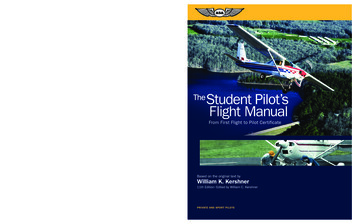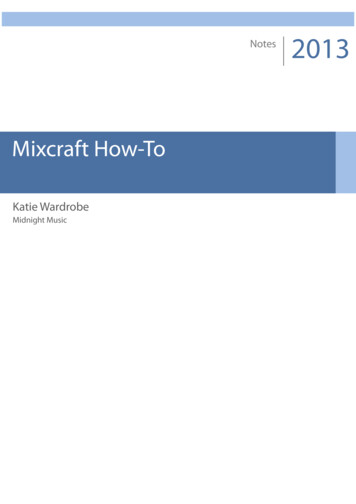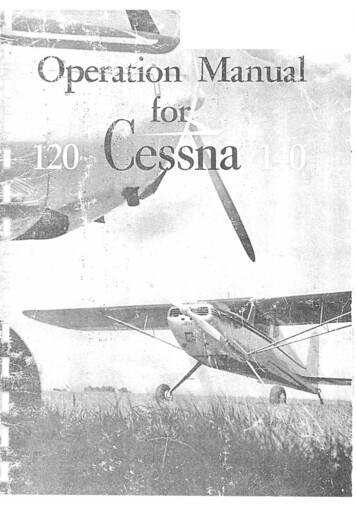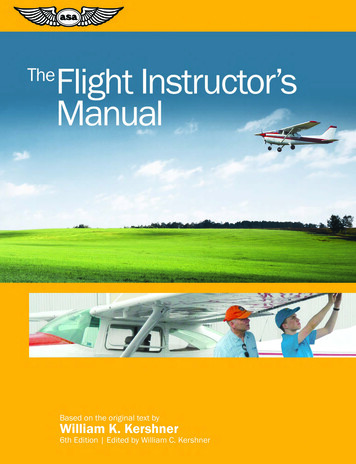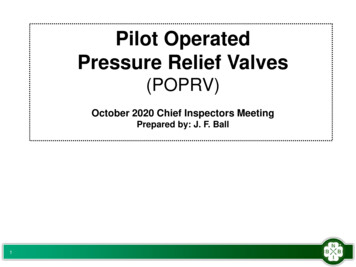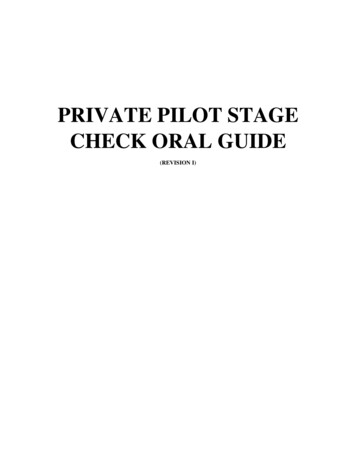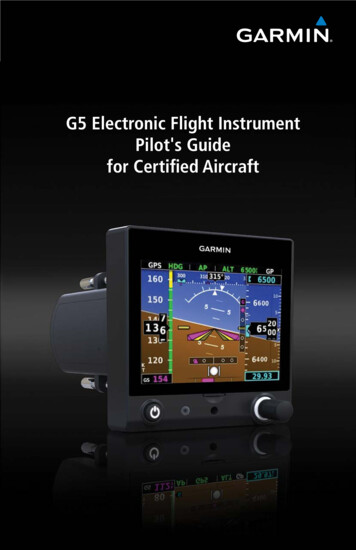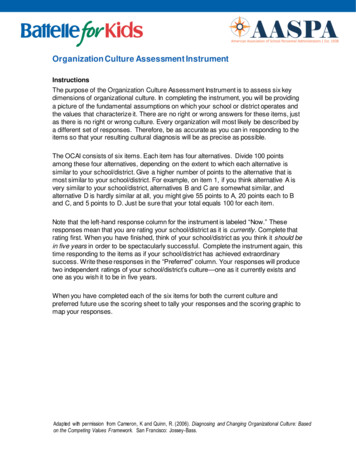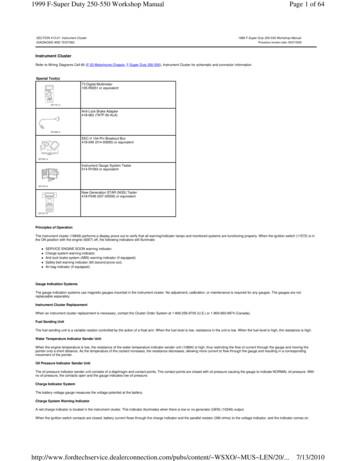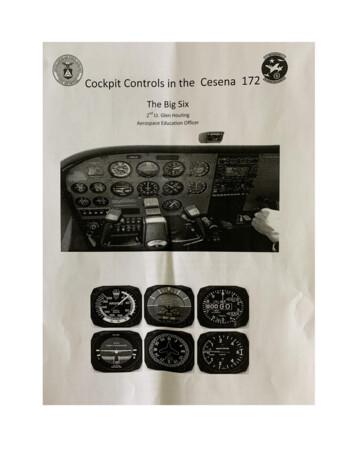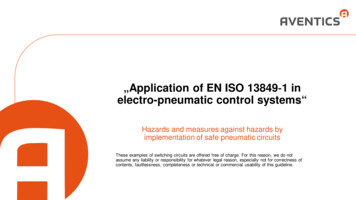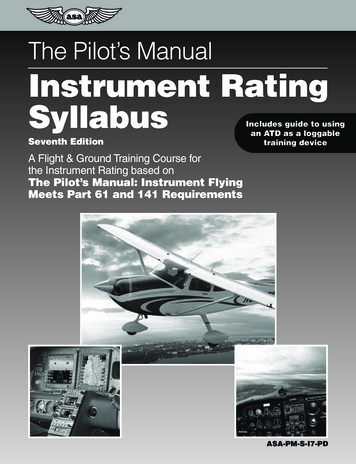
Transcription
The Pilot’s ManualInstrument RatingSyllabusSeventh EditionIncludes guide to usingan ATD as a loggabletraining deviceA Flight & Ground Training Course forthe Instrument Rating based onThe Pilot’s Manual: Instrument FlyingMeets Part 61 and 141 RequirementsASA-PM-S-I7-PD
The Pilot’s ManualInstrument RatingSyllabusSeventh EditionA Flight & Ground Training Course forthe Instrument Rating based onThe Pilot’s Manual: Instrument FlyingMeets Part 61 and 141 Requirementsby Jackie SpanitzAVIATION SUPPLIES & ACADEMICSNEWCASTLE, WASHINGTON 1995–2020 Aviation Supplies & Academics, Inc. All rights reserved.7005 132nd Place SE, Newcastle, Washington 98059 USAVisit the ASA website often, as any updates due to FAA regulatory andprocedural changes will be posted there: www.asa2fly.comASA-PM-S-I7-PDIncludes guide to usingan ATD as a loggabletraining device
ContentsAbout this Syllabus. iiiCompliance Tables. vEnrollment/Graduation Certificates.viiStage 1Instrument Flight. 1Module 1. 2Module 2. 3Module 3. 4Module 4. 5Module 5. 6Optional Review. 7Stage 2Navigation. 8Module 1. 9Module 2. 10Module 3. 11Module 4. 12Module 5. 13Optional Review. 14Stage 3Holding Procedures. 15Module 1. 16Module 2. 17Module 3. 18Module 4. 19Module 5. 20Optional Review. 21Stage 4Instrument Approaches. 22Module 1. 23Module 2. 24Module 3. 25Module 4. 26Module 5. 27Optional Review. 28Stage 5En Route & Prep for Checkride. 29Module 1. 30Module 2. 31Module 3. 32Module 4. 33Module 5. 34Optional Review. 35Instrument Rating Endorsements and Checkride List. 36Airman Certificate Application FAA Form 8710-1. 37Stage Exams 1–5.43–58Stage Exam Figures.59–76Aviation Training Device (ATD) Syllabus.77–86Aviation Supplies & Academics, Inc.Instrument Rating Syllabusii
About This SyllabusCourse ObjectiveThe objective of this syllabus is for the student to gain the necessary aeronautical skill, knowledge and experience tomeet the requirements of an instrument rating with an airplane category and a single-engine land class rating.PrerequisitesThe student must be able to read, speak, write, and understand the English language, meet the physical standardsfor a third-class medical certificate, and possess either a private pilot or commercial pilot certificate with an airplanecategory and single-engine land class rating.Experience Requirements for an Instrument Rating Include 35 hours of instrument experience for Part 141 (40 hours for Part 61 programs, 15 hours of which must be with aninstrument instructor) 50 hours cross-country PIC (Part 61 programs) 30 hours of ground training (no minimum time is specified for Part 61 programs)Instrument Rating CourseThe instrument rating is made up of two requirements: aeronautical skill and aeronautical knowledge. This syllabusis written to satisfy 14 CFR Part 141 requirements. This syllabus will be equally effective for 14 CFR Part 61programs with the addition of 5 hours of instrument flight training and 50 hours cross-country PIC experience.This syllabus is organized into five stages, with five modules in each stage. Each stage must be completed indays, not to be more than 90 days. Each module contains both a ground and flight lesson. This presents an integratedflight training process and will promote easier learning and a more efficient flight training program. Ideally, theground lesson will be completed prior to the flight lesson.Testing ProceduresEach module contains a reading assignment associated with the ground training program. The review questionsfollowing each chapter will test the student’s understanding of the material covered throughout the ground lesson,and must be answered prior to moving on to the next module. A stage exam is included with each stage, testing thestudent on both the ground and flight training material covered throughout the stage. This exam must be passed witha minimum score of 80%, and reconciled to 100%, in order to proceed to the next stage.It is essential that the objective of each module be accomplished before moving on to the next module. Instructorsare responsible for ensuring the completion standards have been met. It may require multiple meetings and/or flightsfor the student to complete all tasks to the defined standards.Minimum RequirementsThe time necessary for the syllabus to qualify for Part 141 operations includes meeting 35 hours of instructionexperience (40 hours for Part 61 programs, 15 of which must be with an instrument instructor), and 30 hours of groundinstruction. This is a minimum time — many factors play into the total completed flight time: frequency of flying,cooperative weather, airplane and instructor scheduling, and lapses in the flight training process. It is recommended thestudent fly at least twice a week. This type of schedule produces the most efficient training, and cuts down on reviewtime. If there is a lapse in between flights, it may be necessary to review maneuvers; use the optional review flightsaccompanying each stage for this purpose (this will allow the student to continue following the syllabus, which isnecessary for a 141 program). Students are also encouraged to maintain training proficiency with an aviation trainingdevice (ATD). See Appendix 6 for details on integrating this technology into the training curriculum. The studentshould feel comfortable performing each task in all previous modules before progressing to the next stage. If studentexceeds more than hours of the minimum Part 141 recommended time allotted per module, the chief flightinstructor must be informed.Aviation Supplies & Academics, Inc.Instrument Rating Syllabusiii
Note: Although there is no requirement for instrument solo flight, it is suggested the student perform IFR procedureswith a safety pilot for additional practice. See 14 CFR §91.109 for safety pilot requirements.Aviation Training DevicesThe FAA has formally recognized the potential of computer-based training devices for use in general aviationinstrument flight training curricula. A qualified ATD is highly beneficial when used under the guidance of anauthorized instructor to obtaining the aeronautical knowledge and skills required for an instrument rating. SeeAppendix 6 for details on implementing ATDs into an integrated flight and ground training instrument curriculum.Although Federal Aviation Regulations require only 35 hours of instrument flight training for an instrument rating,the national average training time is closer to 65 hours. ATDs are superb instructional tools, taking the teachingprocess out of a hostile environment (the training airplane) and moving it to the computer. All aspects of thetraining curriculum should be taught to some performance level on the ground before demonstrating competencein the airplane. This positive transfer of learning will greatly reduce the flying hours spent working on earning theinstrument rating.Required Materials for the Instrument Rating Course The Pilot’s Manual: Ground School (#ASA-PM-2) The Pilot’s Manual: Instrument Flying (#ASA-PM-3) ASA FAR/AIM (#ASA-FR-AM-BK, updated annually)Recommended Materials for the Instrument Rating Course FAA Instrument Airman Certification Standards (referred to as ACS; replaces PTS) (#ASA-ACS-8) ASA Instrument Rating Test Prep book (#ASA-TP-I), Instrument Rating Prepware software (#ASA-TW-I),or Instrument Pilot Virtual Test Prep DVD ground school (#ASA-VTP-I) ASA Instrument Pilot Oral Exam Guide (#ASA-OEG-I) ASA Flight Computer (#ASA-E6B or #ASA-CX-3) ASA Instrument Plotter (#ASA-CP-IFR) ASA Flight Planner for cross-country flights (#ASA-FP) View limiting device such as Jiffyhood (#ASA-H2G), or Overcasters (#ASA-OVC) ASA Flightlogs for cross-country flights (#ASA-FP) Low Altitude Enroute Chart for local area Sectional Chart for local area Chart Supplements (previously Airport/Facility Directory)This syllabus uses The Pilot’s Manual: Instrument Flying for the ground training program. The review followingeach chapter should be finished with the assigned reading. This textbook contains an index which will help pinpointthe material for the subject you are working on. ASA’s Instrument Rating Test Prep is recommended to enhance theprogram. The prep will ensure the student is completely prepared for the FAA Knowledge Exam upon completionof the course. Instructors using this syllabus must ensure current Airman Certification Standards are upheld and theprocedures outlined in the Instrument Flying Handbook (FAA-H-8083-15) are maintained at all times.If you have any comments or questions on how to best use this syllabus, please call ASA at 425-235-1500.We will be happy to provide suggestions on how to tailor this syllabus to specifically meet your training needs. Noteto instructors: Answers to the stage exams are available to instructors by emailing cfi@asa2fly.com, or you can faxyour request on letterhead to 1-425-235-0128.FAA Safety Team WINGS Pilot Proficiency ProgramThe WINGS Program is based on the premise that pilots who maintain currency and proficiency in the basicsof flight will enjoy a safer and more stress-free flying experience. As part of this course, it is recommended thatstudents sign up for a WINGS account at FAASafety.gov to gain access to additional free resources that willsupplement ongoing training and proficiency.Aviation Supplies & Academics, Inc.Instrument Rating Syllabusiv
Instrument Rating Minimum Course HoursFor Part 141, Appendix C ComplianceThese times are for student/instructor guidance only. They are a suggested time schedule which will ensureminimum ground training and flight time compliance with Part141. To follow a Part 61 curriculum, add 5 hours ofinstrument training, for a total of 40 hours. Part 61 instrument rating applicants are also required to have 50 hourscross-country PIC time.Note: Ground instruction should include classroom discussion, and pre- and post-flight briefings. The stage examsmay not be credited for more than 5 hours of the 30 hours of required ground training, and the stage checks may notbe credited for more than 5 hours of the required 35 hours of flight training.PageGround InstructionDual InstrumentFlightDual InstrumentCross-Country01020304050607Stage 1Module 1Module 2Module 3Module 4Module 5* Review1.51.01.01.01.5 Stage Exam1.51.51.01.01.01.5 Stage Check1.508091011121314Stage 2Module 1Module 2Module 3Module 4Module 5* Review1.51.01.01.01.5 Stage Exam1.51.51.01.01.01.5 Stage Check1.515161718192021Stage 3Module 1Module 2Module 3Module 4Module 5* Review1.51.01.01.01.5 Stage Exam1.51.51.01.01.01.5 Stage Check1.522232425262728Stage 4Module 1Module 2Module 3Module 4Module 5* Review1.51.01.01.51.5 Stage Exam1.51.51.01.01.51.5 Stage Check1.529303132333435Stage 5Module 1Module 2Module 3Module 4Module 5* Review1.51.01.51.01.5 Stage Exam1.52.02.03.51.51.5 Stage Check1.52.02.03.5TOTALS30.0 Stage Exams35.0 Stage Checks7.5Done * Reviews are not necessary to meet Part 141 compliance and are not counted in the totals for the program.They are optional and should be used if the student is not ready to move on to the next module.Aviation Supplies & Academics, Inc.Instrument Rating Syllabusv
These are the aeronautical knowledge subjects and flight tasks required for §141 compliance and wherethey are covered within this syllabus.Part 141 Appendix C — Ground TrainingCovered in Syllabus1 Applicable Federal Aviation Regulations for IFR flight operationsStage 3, Module 22 Appropriate information in the Aeronautical Information ManualStage 3, Module 23 Air traffic control system and procedures for instrument flight operationsStage 3, Module 34 IFR navigation and approaches by use of navigation systemsStage 2, all Modules5 Use of IFR en route and instrument approach procedure chartsStage 4, Module 16 Procurements and use of aviation weather reports and forecasts, and the elements offorecasting weather trends on the basis of that information and personal observation ofweather conditionsStage 3, Module 47 Safe and efficient operation of aircraft under instrument flight rules and conditionsStage 5, Modules 1, 2, 38 Recognition of critical weather situations and wind shear avoidanceStage 2, Module 4Stage 3, Modules 4 and 5Stage 5, Module 29 Aeronautical decision making and judgmentStage 3, Module 310 Crew resource management, to include crew communication and coordinationStage 1, Module 1Stage 3, Module 3Part 141 Appendix C — Flight TrainingCovered in Syllabus1 35 hours of instrument trainingStages 1–5, all modules2 Dual instruction from an instrument instructor that includes one cross-country flight inairplane single-engine landStage 5 Modules 1, 2, 33 One dual cross-country at least 250 NM along airways or ATC-directed routing with onesegment of the flight consisting of at least a straight-line distance of 100 NM betweenairports and including an instrument approach at each airport and three different kinds ofapproaches with the use of navigation systemsStage 5 Module 3Aviation Supplies & Academics, Inc.Instrument Rating Syllabusvi
Enrollment Certificatehis is to certify thatStudent Nameis enrolled in the Federal Aviation Administration approvedInstrument Rating Course, conducted bySchool and Certificate NumberChief InstructorDate of EnrollmentGraduation Certificatehis is to certify thatPilot Name and Numberhas satisfactorily completed each required stage of the approvedcourse of training including the tests for those stages, and hasreceived hours of cross-country training.has graduated from theFederal Aviation Administration approved Instrument RatingCourse conducted bySchool and Certificate NumberChief InstructorAviation Supplies & Academics, Inc.Date of GraduationInstrument Rating Syllabusvii
Stage 1Instrument FlightObjectiveThe objective of Stage 1 is for the student to become proficient in and have an understanding of the following:Ground TrainingFlight Training Course objectiveSchool requirements, procedures, regulationsGrading criteriaResource managementInstrument scan techniquesIFR instrumentsStraight-and-level flightStraight climb and descentTurningUnusual flight attitudesNormal instrument flight on a partial panelTraining maneuvers used for instrument flightFlight training processTraining airplaneInstrument preflightAircraft systems related to IFR operationsInstrument cockpit checkFlight by reference to instruments:straight-and-level flightchange of airspeedconstant airspeed climbs and descentsrate climbs and descentstimed turns to magnetic compass headingssteep turnsrecovery from unusual flight attitudes Loss of gyro attitude and/or heading indicators Checking instruments and equipment post flightNote: The patterns used in this Stage can be foundin Instrument Flying, Chapter 9.Completion StandardsStage 1 is complete when the student achieves the objective of each lesson and can list or describe the correctprocess or reference for accomplishing elements, exercises and activities. Student shall score at least 80% on theStage 1 Exam, and all deficient areas shall be reconciled to 100%.Aviation Supplies & Academics, Inc.Instrument Rating Syllabus1
Stage 1 / Module 1Minimum 141 Requirements: Dual, InstrumentGround TrainingFlight TrainingObjective:Objective:For the student to have an understanding of the instrument ratingcourse, and instrument scanning techniques.For the student to be introduced to the instrument rating courseand become familiarized with the training airplane, instrumentpreflight, and straight-and-level instrument flight.Content: Review of course and objectives School requirements, procedures, regulations Grading criteria, expectations of student Review objective of Stage 1Resource management SRM and CRMInstrument scanning technique Selective radial scan Basic T-scan1.5 hours flight1.5 hours ground instructionContent: Discussion of flight training process Introduction to the training airplane Instrument preflight inspection and aircraft documents Use of checklists Normal takeoff Instrument scan Straight-and-level flight Pattern A (see Chapter 9) Other scans Pattern B (see Chapter 9)Completion Standards: Radar vectors, VOR approach (demonstrated)This lesson is complete when the student has successfullycompleted all review questions following the assigned reading.Assignment:Instrument Flying, Introduction and Chapters 1 and 2This lesson may be completed using ATD Lesson 1.See Appendix 6. Pattern C (see Chapter 9) PostflightCompletion Standards:This lesson is complete when the student can conduct an efficientinstrument preflight and scan, and can maintain altitude within200 feet, airspeed within 20 knots, and heading within 20 degrees,while performing the maneuvers listed in the content of thismodule.Recommended Reading:Instrument FlyingStage 1 / Module 1Date of Completion:Signature:Time Flown:AircraftAviation Supplies & Academics, Inc.ATDInstrument Rating SyllabusOther2
Stage 1 / Module 2Minimum 141 Requirements: Dual, InstrumentGround TrainingFlight TrainingObjective:Objective:For the student to gain an understanding of the aircraft instrumentsused in instrument flight, and the concept of flying straight-andlevel under instrument conditions.For the student to become acquainted with the aircraft systemsrelated to IFR operations, the instrument cockpit check, and tobecome proficient in flight by reference to instruments whilemaintaining changes of airspeed, and constant airspeed climbs anddescents.Content:Instruments Attitude indicator Power indicators Airspeed indicator Heading indicator Altimeter Vertical speed indicator Turn coordinator and turn indicator Magnetic compass Clock Pitot-static system Gyroscopes Preflight checks of flight instruments PFD (if training aircraft warrants)Straight-and-level flight Control instruments Performance instruments Three fundamentals of instrument flying Trimming Cruise speeds vs. pitch attitudes Maintaining heading Maintaining altitude1.0 hours flight1.0 hours ground instructionContent: Discussion of aircraft systems related to IFR operations Instrument cockpit check and preflight Normal takeoff Instrument scan Straight-and-level flight Standard rate turns Demonstrate effects of change of airspeed Constant airspeed climbs and descents Pattern D (see Chapter 9) Pattern E (see Chapter 9) Pattern F (see Chapter 9) Radar vectors, ILS approach (demonstrated) PostflightCompletion Standards:This module is complete when the student can effectively controlthe airplane within 200 feet, 20 degrees, and 20 knots, and performstandard rate turns, while performing the maneuvers listed in thecontent of this module.Recommended Reading:Instrument Flying Recovering from slightly unusual attitudes Coping with a faulty attitude indicator Power vs. speedThis lesson may be completed using ATD Lesson 2.See Appendix 6. Changing configuration SRM and CRMCompletion Standards:This lesson is complete when the student has successfullycompleted all review questions following the assigned reading.Assignment:Instrument Flying, Chapters 3 and 4Stage 1 / Module 2Date of Completion:Signature:Time Flown:AircraftAviation Supplies & Academics, Inc.ATDInstrument Rating SyllabusOther3
Stage 1 / Module 3Minimum 141 Requirements: Dual, InstrumentGround TrainingFlight TrainingObjective:Objective:For the student to gain an understanding of the straight climb anddescent, and turning during instrument flight.For the student to become proficient in performing steep turns andslow flight solely by reference to instruments, and to understandthe process of checking the instrument and equipment postflight.Content:The straight climb Climbing at different airspeeds Variations on entering the climb Climbing at a particular rate Climbing into clouds after takeoffThe straight descent Climbing away from a descent Descending at a particular rate The precision approach1.0 hours flight1.0 hours ground instructionContent: Preflight inspection Normal takeoff Standard rate turns Slow flight Steep turns Pattern I (see Chapter 9) Pattern E (see Chapter 9) Radar vectors, nonprecision approach (demonstrated)Turning Postflight, checking instruments and equipment Bank angle and rate of turnCompletion Standards: Roll-in and roll-out rateThis module is complete when the student can perform steepturns, slow flight solely by reference to instruments, and postflightprocedures, and can maintain flight within 150 feet, 15 degrees,15 knots, and 5 degrees of bank angle while performing themaneuvers listed in the content of this module. The medium level turn Instrument turns to a specific heading Climbing turns Descending turns Steep turns Steep level turnRecommended Reading:Instrument Flying Steep descending turnCompletion Standards:This lesson is complete when the student has successfullycompleted all review questions following the assigned reading.Assignment:Instrument Flying, Chapters 5 and 6This lesson may be completed using ATD Lesson 3.See Appendix 6.Stage 1 / Module 3Date of Completion:Signature:Time Flown:AircraftAviation Supplies & Academics, Inc.ATDInstrument Rating SyllabusOther4
Stage 1 / Module 4Minimum 141 Requirements: Dual, InstrumentGround TrainingFlight TrainingObjective:Objective:For the student to have an understanding of recognizing andrecovering from unusual attitudes.For the student to become proficient at performing timed turns tomagnetic compass headings, and constant rate climbs and descents,flying solely by reference to instruments.Content:Unusual attitudes Recognizing an unusual attitude Nose-low attitudes with increasing airspeed Nose-high attitude with decreasing airspeed1.0 hours flight1.0 hours ground instructionContent: Preflight Soft-field takeoff Standard rate turns Nose-high and approaching the stall Steep turnsCompletion Standards: Power on/off stallsThis lesson is complete when the student has successfullycompleted all review questions following the assigned reading.Assignment:Instrument Flying, Chapter 7 Slow flight Timed turns to magnetic compass headings Pattern G (see Chapter 9) Pattern H (see Chapter 9) Systems and equipment malfunctions ASR approach (with tower or the instructor)This lesson may be completed using ATD Lesson 4.See Appendix 6. Postflight proceduresCompletion Standards:This module is complete when the student can maintain flightwithin 150 feet, 15 degrees, and 15 knots, while performing themaneuvers listed in the content of this module.Recommended Reading:Instrument FlyingThis lesson may be completed using ATD Lesson 5.See Appendix 6.Stage 1 / Module 4Date of Completion:Signature:Time Flown:AircraftAviation Supplies & Academics, Inc.ATDInstrument Rating SyllabusOther5
Stage 1 / Module 5 andStage CheckMinimum 141 Requirements: Dual, InstrumentGround TrainingFlight TrainingObjective:Objective:For the student to gain an understanding of normal instrumentflight on a partial panel and the maneuvers used in instrumentflight training.For the student to become proficient in recovery from unusualflight attitudes, and partial panel flight. For the Stage Check,student should demonstrate skill in the following areas accordingto the completion standards.Content:1.5 hours flightStage check1.5 hours ground instructionStage examContent:Normal instrument flight on a partial panel Interpreting pitch attitude on a partial panel Interpreting bank attitude on a partial panel Straight flight on a partial panel Straight-and-level flight on a partial panel Climbing on a partial panel Preflight inspection Aircraft systems related to IFR operations Instrument cockpit check Short-field takeoff Straight-and-level flight Change of airspeed Descending on a partial panel Constant airspeed climb and descents Turning on a partial panel Recovery from unusual attitudes on a partial panelTraining maneuvers Rate climbs and descents Standard rate turns Steep turns Seven-Ts Slow flight Performance sheets Power on/off Stalls Warm-ups Maneuvers (A-K) Timed turns to headingsCompletion Standards: Partial panel practice using patterns B and G Recovery from unusual flight attitudesThis lesson is complete when the student has successfullycompleted all review questions following the assigned reading.Stage 1 Exam must be passed with a minimum score of 80% andreconciled to 100%. Pattern J (see Chapter 9) Pattern H (see Chapter 9) Radar vector approach, instructor
Aviation Supplies & Academics, Inc. Instrument Rating Syllabus iv Note: Although there is no requirement for instrument solo flight, it is suggested the student perform IFR procedures with a safety pilot for additional practice. See 14 CFR §91.109 for safety pilot requirements. Aviation Training Devices The FAA has forma
